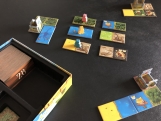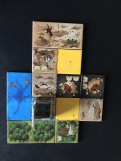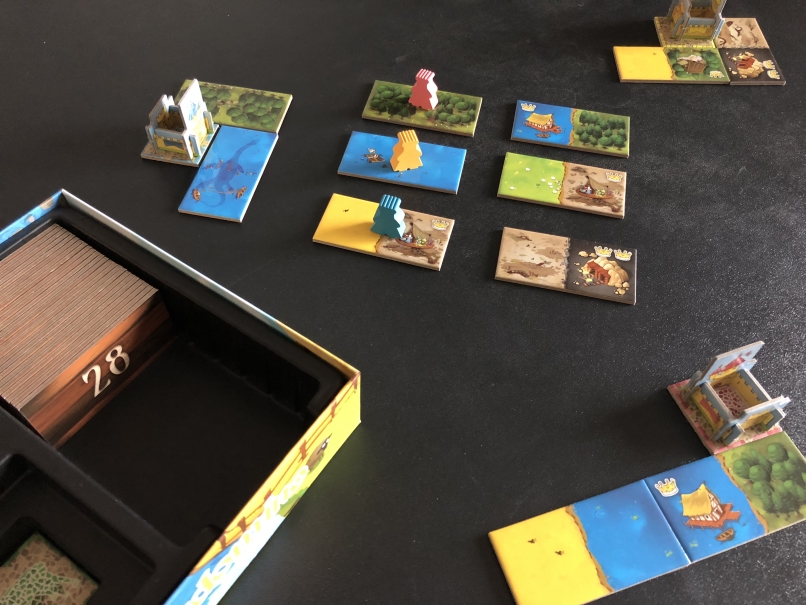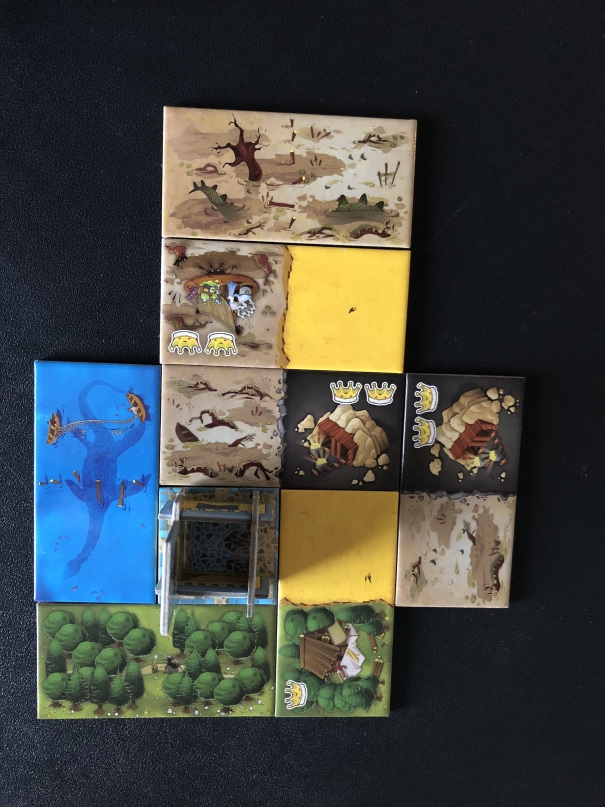
WE PLAY 2 LEARN
Game Ratings
FAMILY
8
YOUNG KIDS
6
OLDER KIDS
8
ADULTS
8
Overview
| Players | Playing Time | Best Age | Educational |
| 2 - 4 | 10-15 minutes | 6 - Adult | Math Spatial Problem Solving |
| Skill | Luck | Strategy | Social | Game Type | Play Style |
| 80% | 20% | 70% | 30% | Tiles | Competitive |
Kingdomino is a game that every family should own. It won the 2017 Spiel de Jahres, the most respected game of the year award. So adults will enjoy playing, but it's also great for kids. It is quick to play, a lot of fun, and very little time is spent waiting for others to take their turn in this game. At a very basic level,
Kingdomino is a tile laying game as its name implies. However, the game play goes far beyond what most of us would think of with dominos.
It also provides some educational value. Placing tiles develops spatial problem solving and a number of math skills will also be exercised throughout the game. But don't worry, Kingdomino is so fun that none of this will feel like a chore to kids or adults.



How to Play
Official Rules
The official rules are available from the manufacturer here. The rules are fairly short and very well explained, including helpful illustrations.
Enhanced Rules
This is a very good game using just the official rules, but with a little customization this becomes a fantastic game as we explain in our Custom Rules section.
FAQ
How many players?
- Playable with 2-4
- Best with 2-4
What ages can play?
- Playable for ages 4* to Adult
- Best for ages 6 to Adult
*If you modify the rules as we suggest in our Custom Rules section, younger kids will be able to play but will still likely be at a disadvantage because of the problem solving. Multiplication is also required for calculating the score at the end, so younger kids would have a hard time playing by themselves.
Can different skill levels or ages play together?
Yes, all skill levels can play together but younger kids will be at a disadvantage.
The basic mechanics of the game are not difficult for even young kids to understand, but they will likely be at a disadvantage in strategically
placing tiles. This can be somewhat alleviated by modifying the rules as we suggest in our Custom Rules section, but young kids
will still have a hard time winning against older kids and adults. However, including young kids will not interfere with the game play for everyone else as each player is creating
their own board.
How long does it take to play?
10-15 minutes
Will we get bored after a few games or does it have good replayability?
This is a very replayable game even though luck is only a minor factor. Each game will require building the board in a different way.
Setup/Cleanup
How much work is it?
Low. For two or three players games, some tiles will need to be removed before play starts, but other than that it plays right out of the box.
Would kids be able to do it on their own?
Setup requires counting to 24 in a two-player game or 12 in a three-player game to remove tiles that will not be used. Other than that, kids as young as 3 could setup and cleanup this game on their own.
However, multiplication is required for calculating the score at the end so young kids would likely not be able to play completely on their own.
Will parents have fun too...
...when playing with the kids?
Yes, each player builds their own board so playing with kids will not remove the challenge for adults.
...without the kids?
Yes. This game is actually intended for older kids and adults (the manufacturer suggest 8+).
Educational Value
What skills will this game help develop?
Number comparison
This is a great game for practicing a number of math skills. The four tiles used each round must be placed in order from low to high before they are chosen,
so this is will help with number comparison. The tiles will be randomly distributed between 1 and 48.
Spatial Problem Solving
Each player will create their own 5x5 board using the tile pieces they select each round. Finding the best way to fit each new tile into the existing board is a fun and challenging
puzzle that will help develop problem solving skills.
Basic Addition and Multiplication
Calculating the score at the end of the game provides additional math practice. This includes basic addition as well as beginning multiplication. This
would typically require multiplying only single digit numbers together.
But will my kids actually have fun playing it?
Yes, as long as your child would enjoy the problem solving aspect. The math required is not the main point of the game.
Game Tips
Improve end of game play
Allow players to discard tiles even when it is not required
Near the end of the game when the board is almost full, it is possible you will need to
place a tile that would violate the placement rules. In this case the tile would be discarded and you would finish with one less tile in your board than the other players.
However, there are other times when you need to place a tile and there is a legal spot on your board for it, but placing it in that spot would disrupt your strategy or prevent you
from placing a better tile in a later round. Per the standard rules you would be required to place the tile in that spot anyways. Allowing a player to instead discard that tile
if they so choose is an option we prefer to use. In practice this will not feel like it makes the game too easy, because the player is still being penalized by losing a tile.
To play with younger kids or across multiple ages/skill levels
Allow younger kids to build the board beyond the 5x5 size limitation.
One of the most challenging parts of the game is to find the highest scoring
spot to place a new tile while following the placement rules and not exceeding the 5x5 overall board size rule. 4-6 year olds will likely struggle with this most. Allowing the board
size to increase to 6 or 7 in one or both dimensions will make this easier. This will not affect the others players directly as each person is building their own board, but we
suggest using this modification only when necessary. Figuring out the best way to build the board is the key element in the game and it would be very possible to make the game too
easy with this modification.
Allow younger kids to ignore tile placement rules.
The standard rules require that at least one edge of a new tile be placed against a matching terrain
type or the starting castle. Ignoring this rule would greatly simplify the game. However, as with the last modification, this has the potential to make the game too easy so we
suggest using it sparingly. If you do choose to use this rule, we advise against using it in conjuction with removing the board size limitation.
Do you use custom rules we haven't thought of? If you have found some other ways to customize the rules, please share them with us through our Contact page. We're always interested in new ways to improve gameplay.
Where to Buy
Similar Games
If you like this game, we suggest these others
Or check out our full list of Reviews where you can sort by any of these categories
We are a participant in the Amazon Services LLC Associates Program, an affiliate advertising program designed to provide a means for us to earn fees by linking to Amazon.com and affiliated sites



